![]()
![]()
![]()
Use LEFT and RIGHT arrow keys to navigate between flashcards;
Use UP and DOWN arrow keys to flip the card;
H to show hint;
A reads text to speech;
45 Cards in this Set
- Front
- Back
|
Outbreak: Affected people had diarrhoea, abdo pain & vomiting. Some cases, mainly children, had haemolytic uremic syndrome. Traced to undercooked minced meat. A. Salmonella B. Mycobacterium bovis (TB) C. Brucellosis D. Norovirus E. Staph aureus F. Yersinia Enterocolitica G. Listeria monocytogenes H. Hepatitis A virus I. Campylobacter J. E. coli O157 |
J. E Coli 0157 |
|
|
Outbreak: An outbreak of gastroenteritis associated with the consumption of oysters in restaurants in UK. A. Campylobacter B. Brucella (Brucellosis) C. Listeria monocytogenes D. Mycobacterium bovis (TB) E. Yersinia Enterocolitica F. Staphylococcus aureus G. Hepatitis A virus H. E. coli O157 I. Norovirus J. Salmonella |
I. Norovirus |
|
|
Outbreak: Outbreaks in which soft cheese made from unpasteurized milk was found to be the common source. An enterotoxin was found in the cheese. A. Listeria monocytogenes B. Salmonella C. Staph aureus D. Norovirus E. Campylobacter F. Yersinia Enterocolitica G. Hepatitis A virus H. Mycobacterium bovis (TB) I. Brucella (Brucellosis) J. E. coli O157 |
C. Staph Aureus |
|
|
Outbreak: An outbreak of GIT illness linked to the consumption of raw egg dishes including mayonnaise and homemade ice cream. A. E. coli O157 B. Listeria monocytogenes C. Campylobacter D. Yersinia Enterocolitica E. Staph aureus F. Salmonella G. Mycobacterium bovis (TB) H. Hepatitis A virus I. Brucella (Brucellosis) J. Norovirus |
f. Salmonella |
|
|
Outbreak: A nationwide outbreak that has already caused several deaths. The authorities blame the prolonged incubation period for the difficulty of identifying the source of the outbreak, which at this stage of the investigation is believed to be pâté. A. Brucella B. Hepatitis A virus C. Mycobacterium bovis (TB) D. Salmonella E. Listeria monocytogenes F. Yersinia Enterocolitica G. Campylobacter H. Staph aureus I. Norovirus J. E. coli O157 |
E. Listeria |
|
|
A rabbit requiring a spot on for prevention of fleas. a) Spinosad (Comfortis) g) Imidacloprid and Permethrin (Advantix) h) Fipronil, Methoprene and Amitraz (Certifect) i) Nitenpyram (Capstar)
|
J. Advantage |
|
|
A stray JRT to be castrated this afternoon - however he is riddled with fleas. a) Spinosad (Comfortis) g) Imidacloprid and Permethrin (Advantix) h) Fipronil, Methoprene and Amitraz (Certifect) i) Nitenpyram (Capstar) |
i. Capstar (works in 15 minutes, 95% effect in 6 hours) |
|
|
A Boxer that cannot have spot on products due to a chronic skin condition, but the owner only wants to tablet him as little as she can as he hates it. Which treatment/product would be most appropriate? a) Spinosad (Comfortis) g) Imidacloprid and Permethrin (Advantix) h) Fipronil, Methoprene and Amitraz (Certifect) i) Nitenpyram (Capstar) |
d. Bravecto (requires tablet once every 3 months) |
|
|
A Labrodor presenting with sarcoptic mange and flea infestation a) Spinosad (Comfortis) g) Imidacloprid and Permethrin (Advantix) h) Fipronil, Methoprene and Amitraz (Certifect) i) Nitenpyram (Capstar) |
E. Stronghold - very good for sarcoptic mange |
|
|
A GSD with Demodecosis. a) Spinosad (Comfortis) g) Imidacloprid and Permethrin (Advantix) h) Fipronil, Methoprene and Amitraz (Certifect) i) Nitenpyram (Capstar) |
f. Promeris Duo - very good for Demodex. |
|
|
A DSH travelling to Australia in 2 months, where she will be at high risk of heartworm and mange. a) Spinosad (Comfortis) g) Imidacloprid and Permethrin (Advantix) h) Fipronil, Methoprene and Amitraz (Certifect) i) Nitenpyram (Capstar) |
C. Advocate (Stronghold has some Dirofilaria effect but no cat mange - Notoedres Cati) |
|
|
A ferret that needs protection from heartworm. a) Spinosad (Comfortis) g) Imidacloprid and Permethrin (Advantix) h) Fipronil, Methoprene and Amitraz (Certifect) i) Nitenpyram (Capstar) |
C. Advocate |
|
|
A border collie that needs long term flea protection and lives with another cat, who mutually groom each other. a) Spinosad (Comfortis) g) Imidacloprid and Permethrin (Advantix) h) Fipronil, Methoprene and Amitraz (Certifect) i) Nitenpyram (Capstar) |
A = 10% vomit, but GOOD! |
|
|
A border collie that requires protection from sandflies, moquitos and stableflies on a 2 week holiday to New Zealand. a) Spinosad (Comfortis) g) Imidacloprid and Permethrin (Advantix) h) Fipronil, Methoprene and Amitraz (Certifect) i) Nitenpyram (Capstar) |
G. The only one to protect against all of these parasites, for 2-4 weeks. |
|
|
Which of the following parasitic diseases is NOT pruritic? |
C. Demodex infestations are rarely pruritic in any species. |
|
|
A biting louse that causes severe pruritis, noticeably along the tail base and shoulders. It should be treated with MLs in the autumn when numbers are low. |
H. in cows. |
|
|
A louse that declines rapidly with UV exposure. Treatment can sometimes lead to lameness due to 2ndry Rhusopathiae. |
J. In Sheep. OP-dip can lead to lameness. |
|
|
A mite that causes EXTREME pruritis and pustules. It is difficult to treat due to its latency over summer and survival in the environment for up to 15 days. |
F. These signs are more in sheep (SCAB MITE) but can also occur in cattle. |
|
|
A condition commonly seen in the cow that is mildly pruritic (mainly on the tail, hindlimbs, udder and perineum) and seen more in housed animals.
a) Cheyeletiellosis |
G. Very common in cows - mite. |
|
|
The louse responsible for this condition is very large and can transmit a fatal pox disease. a) Cheyeletiellosis |
I. Swine Pox <6mm long. |
|
|
Which one of the following is a zoonotic condition that can be seen as many tiny pustules on the lower arms of a human?
a) Cheyeletiellosis |
A. Surface mite |
|
|
Which one of the following can go on to cause eosinophilic-granuloma complex in cats?
a) Cheyeletiellosis |
E. FAD. |
|
|
Which of the following is a notifyable condition if seen in horses in the UK?
a) Cheyeletiellosis b) Trombiculosis |
D. |
|
|
Which of the following conditions is difficult to diagnose with just the naked eye and a microscope, due to its lack of eggs?
a) Cheyeletiellosis |
D. >50% cases are egg -ve, therefore look for faeces too and mainly response to treatment. |
|
|
Intermittent exposure of the causative parasite is most likely to cause which condition? |
E. FAD |
|
|
Which of the following pathogens is responsible for causing "Fleece Rot" in sheep and "Mud Fever" in horses? |
A. |
|
|
A dog presents with non-pruritic, dermal crusts with satellite lesions. Which is the most likely cause?
a) Dermatophilosis |
J. Furunculosis (Deep Pyo) always requires C&S as only 60% cases are due to Staph. |
|
|
A dog presents with pruritis disease on his ventral abdomen and trunk. He has a 'moth-eaten' appearance with epidermal collarettes. Most likely pathogen? |
i. Superficial Pyo is caused by S. Pseudo in 90% of cases |
|
|
A sheep presents in November with extreme pruritis and a matted fleece. Beneath this she is covered in pustules, as are most of the other sheep. Most likely pathogen?
|
B. Sheep Scab mite |
|
|
A pig present with pruritis and possible signs of Swine Pox. Most likely pathogen?
|
C. H. Suis, the Hog Louse |
|
|
A JRT presents with non-pruritic, asymmetrical alopecia with erythema on his nose and face. The owner says he often runs off of his lead and sniffs around the woods out of sight... Most likely pathogen? |
H. Dermatophytosis from hedgehogs, commonly seen on the face of terrier breeds that are inquisitive. |
|
|
Several cows present to you with thick grey plaques on their face and ears. Most likely pathogen?
|
D. Dermatophytosis in cows. |
|
|
A nearby dairy farm has been having a problem with louse recently, when he suddenly calls and says his calves are looking very pale and weak.. Most likely pathogen? |
E. A suckling louse that causes anaemia in calves. |
|
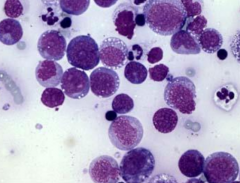
A cat presents with dyspnoea and weight loss. You perform a thoracic tap and this is what is shown under cytology. a) Granulomatous Lymphadenitis |
D. Metastatic, but in the thymus, NOT LN. |
|
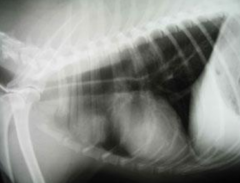
A dog presents with dysphagia and dyspnoea. X-Rays show the above. Dx? a) Granulomatous Lymphadenitis |
E. Paraneoplastic signs of megao due to myaesthenia gravis are also present |
|
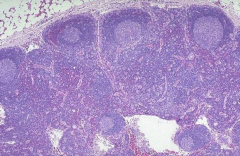
A dog presents with large LNs. Aspirate reveals the above. Dx? a) Granulomatous Lymphadenitis |
F. Normal architecture. Secondary germinal centres seen, just increased number of cells. |
|
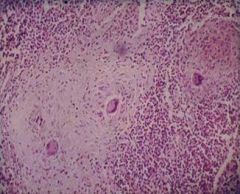
A dog presents with large LNs. Aspirate reveals the above. Dx? a) Granulomatous Lymphadenitis |
i. Areas of necrosis and loss of architecture seen, with some normal germinal centres. |
|

A dog presents with large LNs. Aspirate reveals the above. Dx? a) Granulomatous Lymphadenitis |
H. No normal architecture seen at all |
|
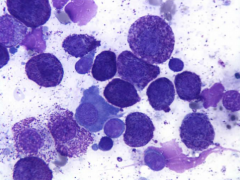
A dog presents with large LNs. Aspirate reveals the above. Dx? a) Granulomatous Lymphadenitis |
G. A mast cell can be seen - this is a metastatic MCT |
|
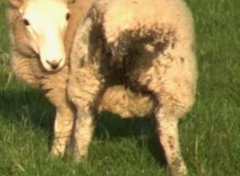
Which of the following would you use to treat this case? |
5. Only licensed treatment for blowfly strike. |
|

Which of the following would you use to treat this case? |
1. This is most likely to be a viral condition (e.g. orf) where there is no treatment, or Dermatophilosis (Mud Fever) where Penicillins would be needed. |
|
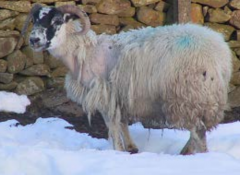
Which TWO of the following could you use to treat this case? |
5. and 6. Most likely to be body lice, therefore one OP dip or pour on SP |
|
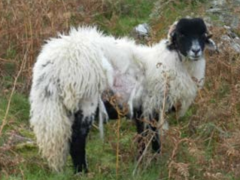
Which TWO of the following could you use to treat this case? |
This is most likely to be sheep scab (mites) as matted fleece and extensive loss, therefore 8. and 6. e.g. Doramectin or Ivermectin |
|
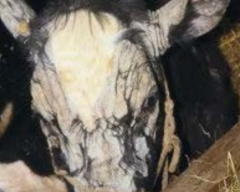
Which one of the following could you use to treat this case? |
4. Enilconazole only licensed. |
|
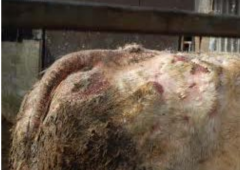
Which one of the following could you use to treat this case? |
8. Most likely to be chorioptic mange, therefore MLs would be best (they are the best for any type of mange in cows) |

